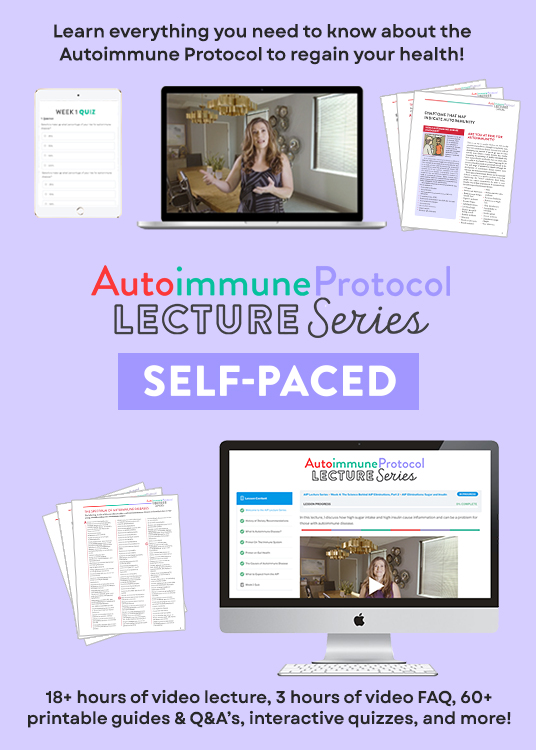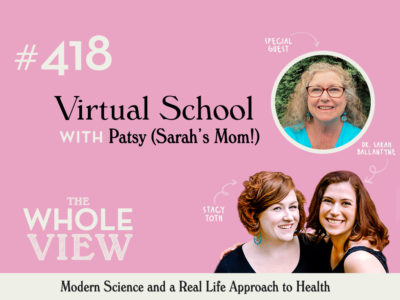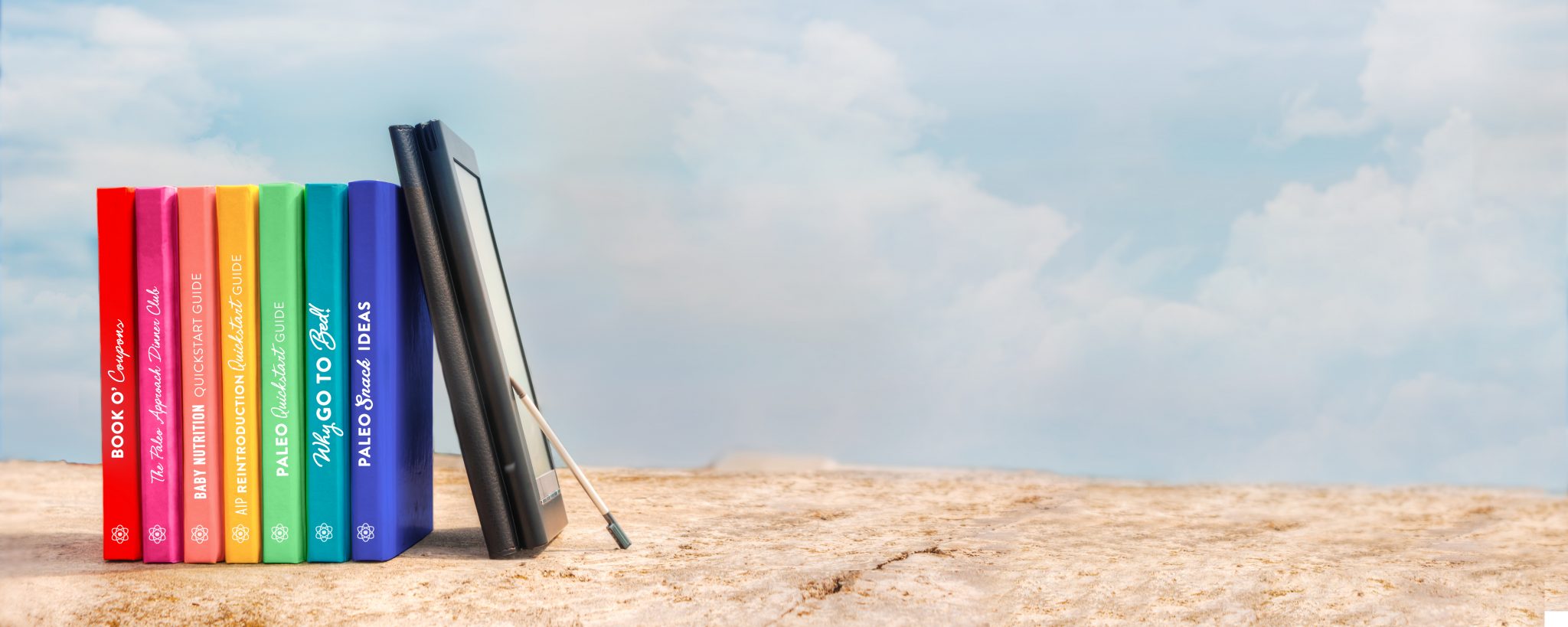Welcome to episode 418 of The Whole View. This week Stacy and Sarah are joined by Patsy, Sarah’s mom, who has been a distance education virtual teacher for the last twenty-seven years. Patsy shares tips from her professional experience in distance learning and provides tangible ideas on how to set yourself and your children up for success!
Table of Contents[Hide][Show]
- The Whole View, Episode 418: Virtual School
- Big Shout Out
- Vocabulary
- Universal Challenges
- The Set-Up
- The Adjustment
- Technology
- Access
- Getting Creative
- Mindset & Ideas
- The Fear of Falling Behind
- How to Overcome the Fear of Falling Behind
- Staying Fully Engaged with Online Learning
- Our Social Environment Control is a Win
- The Positive Outlook
- Stacy’s Takeaway
- Sarah’s Takeaway
- Closing Thoughts
If you enjoy the show, please review it on iTunes!
The Whole View, Episode 418: Virtual School
Welcome back to the Whole View, episode 418. (0:27)
Stacy is super excited to welcome back a guest to the show, although no stranger to the show, Sarah’s mom – Patsy.
Like most shows, this topic was selected out of a real-life question that Stacy is facing.
Sarah has insider information on this topic, and Stacy told Sarah that she has to share this wealth of information.
Many listeners are starting this process for the first time, but Sarah’s mom has been teaching for a very long time.
Her expertise is much needed!
This was very fun for Sarah to have her mom on the show and to shop talk.
Sarah’s mom has been a distance education virtual school teacher for most of the last twenty-seven years.
She has been an amazing resource for Sarah’s family as they have navigated this new environment.
Save 70% Off the AIP Lecture Series!
Learn everything you need to know about the Autoimmune Protocol to regain your health!
I am loving this AIP course and all the information I am receiving. The amount of work you have put into this is amazing and greatly, GREATLY, appreciated. Thank you so much. Taking this course gives me the knowledge I need to understand why my body is doing what it is doing and reinforces my determination to continue along this dietary path to heal it. Invaluable!
Carmen Maier

Patsy has a lot of valuable information to share with our listeners because this is such a new area we are navigating.
One thing that Patsy wanted to note is that she will be sharing information from her experience, but does not represent any particular educational institutions.
Patsy feels very honored to be able to share this information.
Stacy’s kids do not start school until September 8 and is currently in complete denial.
Big Shout Out
We are going to talk a lot about the perception of students and what it is like for parents. (5:22)
However, Stacy wants to give a shout out to all the teachers who didn’t sign up to be distance learning teachers and who are now trying to make the most of it.
Patsy echoed her appreciation and excitement for how teachers are rising to meet the challenges.
Sarah saw an estimate that approximately one billion students will be going to school in a virtual environment this fall, globally.
Patsy shared a bit about what happened during the last pandemic in 1918 and the differences we face now.
Things have changed so much since Patsy started her career in virtual distance learning, the resources alone have completely changed.
Technology has gotten to the point where it can disappear, and everyone can simply focus on learning.
We are primed to embrace the solution.
And we have a lot of things going for us in a really positive way.
Vocabulary
Patsy broke down the vocabulary around distance education. (9:24)
Correspondance school was one of the first phrases used in America in 1728.
This was when business correspondence courses became available.
Distance education appeared in the literature in 1892 and this was through the University of Wisconsin.
In Florida, they started using the term virtual schools about twenty to thirty years ago.
Then we gradually got into using the term online learning, which is the term that we are switching to.
For about ten years we played with the term distributed learning, which was never picked up.
Now the general term that we use is online learning, but we are still switching between this phrase and distance education.
These two terms mean the same thing.
We also talk about blended learning and face-to-face learning.
Many school districts are looking at this model to see if this will help us both limit the spread of the coronavirus, while still providing students with a classroom experience.
Every school district is set up a little differently and each school is approaching this differently as well.
Laying the groundwork with the vocabulary, Sarah noted, is the way for us to lay the groundwork to set our kids up for success.
Synchronous means that we are all doing it at the same time together.
Asynchronous is when you are doing it at your own pace and at the time of day that works for you.
Patsy feels that having a blended model works great because both social needs are being met, along with encouraging students to work at their individual level and at their own pace.
Accommodations are when we change the curriculum/assignments a little bit to individualize for students.
A modification is for students who are really struggling and suffering from an extreme amount of anxiety or who have distinct learning challenges.
Universal Challenges
The place where Patsy likes to start is with the home facilitator. (16:44)
This can be a parent, guardian, grandparent, or older sibling, and is an incredibly important role.
You have your children learning from home now and it is a pandemic, this isn’t forever, but you are going to have to take on a hugely supportive role.
This will not always be easy because some kids do not do homework well with their parents.
However, it is a task that you will have to work through and relationship build around.
Patsy likes to say to parents, whatever grade your child is at right now, you are redoing that grade now.
If your child is in grade five, this year you are also in grade five.
You will know the curriculum and go through the details pretty much at the same level that your child is going through.
The Set-Up
Set up your child. (18:20)
Make sure that they have a space that works for them.
Also, make sure that you are having conversations where your child is participating and being involved in the decisions that are being made about where they are going to work in the home.
Patsy shared some location examples.
Students all have different comfort areas where they learn the best.
Let them try out what they think is going to work and then set a time for reassessing it.
Some kids work well with music, some with social contact, and some find these elements to be distractions.
So this is all very individual.
However, it is a great opportunity for kids to assess what kind of learning environment they are most comfortable in.
Work together to evaluate what kind of learning environment works best for the student.
Consider social interactions, how well they are doing with their assignments, and how much help they need.
You are then teaching these kids to self-assess and to be aware of who they are as learners.
This is considered a twenty-first-century learning skill that carries over into the rest of your future.
These are very powerful skills.
The Adjustment
The first two weeks can feel like chaos. (21:17)
Be patient, be kind to yourself – parents, kids, teachers.
After about two weeks, everything kind of settles down and you start to get into your groove.
Once you find that groove you begin to identify where you can tweak things a bit.
Also, make sure that you ask for your help when you need help.
Sarah shared a bit about how their school is currently structured for her daughters.
One of the things that they have done is set up an entire section of this online platform that is just for communication between parents/at-home facilitators and the teachers.
Sarah has really enjoyed being able to see that immediate communication and she feels more connected with what her kids are doing.
Patsy noted that there are elements to these adaptations that will have the potential to roll over to life after the pandemic and benefit us in positive ways.
Technology
The first thing is that every child needs to have their own computer. (26:04)
This computer needs to have a good keyboard, a good screen, and a good connection to the internet.
It also needs to have the software that they are going to need.
A lot of parents are terrified about their kids being online all day and if they are going to go to sites that are dangerous.
However, it is very important to not load up the computer with so much security that kids can’t do anything on their computer.
This adds a lot of frustration to the learning and before long you have an uncooperative student and is resisting doing anything.
Patsy uses Windows Defender on her PC, which is enough security.
From there, it is important to teach your kids to not open a link when they get an email that might contain a virus.
Teach them how to do safe searches.
Part of your job as a home-facilitator is to be checking-in and knowing what your child is doing on the computer.
It doesn’t have to be a war, but it is important to build awareness and open dialogue around this.
Access
Stacy noted that it is a privilege to be home and provide this level of supervision. (28:57)
For most people, Stacy included, it means that she is sacrificing her job in order to provide this oversight.
There are also students who are being asked to learn virtually who do not have access to all that Patsy is noting as needed.
In addition, there are students who simply do not have a home-facilitator available.
Stacy asked for suggestions on how to manage these scenarios and how to find a middle ground.
Patsy noted that this is a huge challenge.
She does think that the government does need to put money towards students’ access to the equipment and internet that they need to be successful.
Because of where unemployment is currently at, many find themselves in a situation where they need to cut expenses, not add to.
These are problems that need to be solved, and we don’t know how long this is going to last.
Patsy can’t answer all of Stacy’s questions but does want to acknowledge that these are very real questions to be answered.
Getting Creative
In Patsy’s work as a distance-ed teacher, she will often have students come to her because the situation in the face to face school was intolerable. (32:55)
It has been heroic the efforts that parents have made to make it work for their kids.
She has seen parents who have gone to shift work, who split responsibilities.
Patsy also worries about students being able to pace at a teacher’s pace with due dates.
Research has shown that the least effective thing that a teacher can do is set due dates.
The most effective thing that teachers can do is this whole array of other things that are broad and open and provide choice.
All of these things are so much more successful for the student as a learner than setting a due date.
The due date adds a lot of stress to a family that is already trying to balance many stressors at once.
Patsy has found that families can be very creative.
When they think through a well-designed learning environment and recognize quickly what is not working to find a solution to identify what does work, success can be found.
Having the flexibility to incorporate everybody’s life realities into the school day is really important.
Communicating these points with the teacher and asking ‘what can we do to make this work with our reality’ can really help with the changes that will need to be made.
Also having these conversations with employers is critical.
Sarah encouraged our listeners that if you have extra, or slightly dated devices, to reach out to schools in your area to see what their needs are.
Or if you have the ability to donate to your local schools, this is another way to support the current demands and fix these inequities.
Mindset & Ideas
Many are probably struggling with the constant changes we are having to meet. (41:53)
When Stacy left corporate America, this is not what she was anticipating for what comes next.
Life has been very different for her, as it has been for a lot of people.
Stacy appreciates Patsy taking the time to breakdown what other people have done to make sacrifices for the education of their children.
It is just a privilege to be educated as it is when we look at this from a global perspective.
Stacy noted that this is a good reminder for her to continue to adapt and navigate the changes as they come.
It is a hard pill for her to swallow, but Patsy’s perspective is very helpful.
Patsy shared the dining room learning experience example for asynchronous learning that has worked well for many families.
It is helpful when siblings can be both audience and helper, as these are important roles in all settings.
They can help each other, and help keep each other on task.
Be really clear about what the goal is.
There are ways of setting this up to minimize the need for parent contact.
Patsy cautions that the oldest child can fall into a babysitter role, which isn’t effective for their learning either.
Also, remember that none of us know how to change to accommodate a pandemic.
If we stay aware, notice what is happening and stay calm, and be kind, we will make it through better than ok.
Doing this peacefully is the best that a lot of families can hope to achieve, and this is huge.
If what you learn during this pandemic is that you can stay calm and believe that you will survive, that will help in your future too.
The Fear of Falling Behind
Sarah raised a point about worries over a gap in education from last academic year’s transition. (46:20)
She noted to her daughters who are feeling this concern that they will catch up.
That there will be a time when they return to in-person learning.
The most important thing is to do the best we can in this situation now and recognize that these challenges we are all facing together.
We are all going to have catch up that we will have to play, and we will all catch up at some point.
There will be accommodations for kids in the future.
The pandemic will have a long tail afterward, so don’t worry about this not being normal.
Don’t worry about this being a different type of rigor in terms of how you are moving through the curriculum.
Do the best you can with how this is right now and we will tackle new challenges as they come.
It is ok to do the best you can for your individual situation.
Sarah knows that a lot of parents are worried about their kids falling behind.
How to Overcome the Fear of Falling Behind
Patsy noted that part of this fear of falling behind is that people are inclined to lean towards passive absorption of the materials when they are working alone, online. (49:23)
They feel that the learning is between them and the computer or them and the piece of paper.
In the classroom, there is a lot of opportunities to discuss every concept, verbally with the class.
So we need to include that piece so that students are actively participating in their learning.
This includes telling people what you have learned.
The home-facilitator can help to have this conversation, other students can help with this (such as a study group), and this will help commit the knowledge to memory.
You can emulate the classroom experience using a number of tools that are available.
This is a very important piece that we need to build into the learning environment for kids who are learning online.
Staying Fully Engaged with Online Learning
Sarah asked Patsy for suggestions on how to get older kids, encourage them, to engage with online learning when they are more inclined not to? (53:19)
Patsy revisited the way that assignment deadlines can create an issue with online engagement and overall burnout.
So first, this is something we need to be aware of.
Just because a student falls off task for a little while, doesn’t mean they will continue to stay off task.
This environment is an environment where students learn a lot about themselves, about what motivates them, about their commitment, and how they develop an independent work ethic.
These are twenty-first-century skills, ones you can take forward into a career.
As a whole, we are moving towards this economy where everyone gets to be their own bosses.
To be successful you need to know how to do that, how to be an independent thinker, and how to be independently motivated and committed to your tasks.
These aren’t necessarily skills that kids are developing in the traditional academic environment, as opposed to distant ed environments.
Stacy echoed her feelings towards the reality that everyone is in the same boat.
It is important to emphasize how important it is to be kind, be patient, and have grace.
No matter what situation you are in, your child is not the only one in that situation.
The entire world is going to learn how to make accommodations and understandings for this very different environment.
We don’t know what that looks like right now.
However, this next generation has an amazing opportunity to shape the world and the environment that they live in.
They will have had access to technological advances that no other generation has had.
Stacy reminds herself that while this is difficult, change comes when you are uncomfortable.
The discomfort, pain, and challenges that we feel right now, will result in some amazing change that can impact the next generation in the way that they approach the world.
Our Social Environment Control is a Win
When you come to social ed you can control the social environment. (1:03:51)
The social environment in a lot of schools deals with bullying as a big issue.
We like to think that sending our kids to school is a great experience, but for a lot of kids, it is traumatic.
When kids come to online education, especially the way learning platforms are structured, most teachers have administered permissions to give an email address and a chat account.
It becomes easiest for them to chat with their other students through that system.
The teachers have access to everything the students do, which allows them to monitor the dialogue and interactions.
Kids, in the comfort and safety of their own home, can turn the computer off, can block a kid, can get away, and are safer than they are in their regular schools.
Being in an online environment is a huge equalizer.
We don’t know what gender a kid is, we don’t know how old they are, what their ethnicity is, whether they have disabilities, what their appearance is, and we can’t tell what their academic abilities are.
In the classroom setting things can get cliquey and it can get rough in that face-to-face environment.
Kids can turn off the distractions, which is very impactful to their overall success.
It can be a very positive experience.
Sarah shared her personal experience with needing to help facilitate social touchpoints while working within the virtual setting.
They have now found these innovative ways to play, even though everyone is in their own homes.
This has been really helpful for them, given that they don’t have the socialization piece of in-person learning.
Patsy did Zoom socials with her students that were successful.
The Positive Outlook
Sarah feels that if she were to distill this episode to one thesis statement, it is that Patsy believes that the online learning environment that is happening globally could end up being a positive thing. (1:11:00)
As a teacher, Patsy (and other educators) have been looking for ways to create educational systems that reflect society and where we are at in the most positive ways and to transform.
The beauty of what technology can do for us at this time is that it has the potential to transform education.
All teachers in the world are being forced to become very creative and use the tools to enhance what they have already embraced.
It is pushing the envelope and opening the doors.
We are becoming much more embracing of learning and people’s interests and motivation and where they are as individuals and learners.
There are so many options in using technology to help us move past any limiting structures as either learners or personally.
Patsy feels that this has the opportunity to be permanently transformative if change can be permanent.
It is a pretty exciting time that Patsy feels has the potential to be absolutely amazing.
If we can overcome the concerns that we discussed earlier about accessibility limitations, we could accomplish a lot of good.
This forces everyone to be creative and to problem-solve, and to problem solve quickly.
There are so many areas where Patsy feels this can work to society’s benefit.
Stacy’s Takeaway
The biggest takeaway for Stacy is being open to creating a kind of pod in their home. (1:14:43)
To set aside the space and the time, a routine and a schedule, for this virtual school.
Stacy loves Sarah’s idea of Zoom lunches!
She will set up something similar for her kids.
Parents in her neighborhood have been sharing pictures of their setups with each other for ideas and inspiration.
Stacy has some new ideas about how to set up the learning environment within their home.
Sarah reflected on what she too has learned about learning environments within the home.
Sarah’s Takeaway
The main takeaway for Sarah in terms of setting up an at-home learning environment is the same takeaway that she learned a decade ago in terms of parenting. (1:20:04)
This has to be individualized for the individual kid.
What works for one kid is not what is going to work for the next kid.
We need to empower our kids with the self-awareness to understand how they learn best.
This is such an important skill.
For Sarah, this is really exciting to think of how to set her kids up for success in a way that is customized to them.
Closing Thoughts
Stacy shared what she learned from one of her children who wanted the autonomy and independence of what they perceived as appropriate for his age. (1:21:29)
They were more successful when given the opportunity to do that on their own and show Stacy that they could handle it.
Patsy said that this is a common experience.
We think we need stricter guidelines as children gain more access to technology when the opposite is actually true.
When you give kids responsibility, you are rewarded tenfold.
Give them the ability to be responsible for their own materials and their own workspace.
It is not a free-for-all, so absolutely be involved with those decisions.
As a parent, you still need to check in to ask how things are working.
Discuss the goals and revisit the goals.
It is a wonderful opportunity!
Having these conversations around something that is education-focused, as opposed to other more personal stuff, leans the conversation to something that can be very positive.
Stacy also noted that more oversight or less oversight is needed per child based on their age, needs, etc.
Patsy noted that it is really important to recognize that a lot of parents are working from home, with children that they too are helping at home.
Probably your teacher is a parent trying to do the same thing, or a grandparent whose grandchildren are doing the same thing.
Know that you are in this boat together.
Be grateful and compassionate.
These are helpful ways to approach all communication.
Recognize how hard everyone is working to make this work for the students.
The beauty of the learning management systems that we have is that it is too simple to ask.
Reach out, edit with compassion, and make your request clear, complete with background information.
Problems will come up, and we have to learn to work through them as opposed to avoid them.
Kids can succeed if they know-how.
Approach this from the mindset that this is a skill that your child needs to develop now.
Look at everything as learning that we are doing.
Embracing a growth mindset is the fundamental positive spin that Sarah plans on bringing forward into this school year.
Huge thank you to Patsy for coming on the podcast and for sharing her wisdom!
Stacy is excited for Patsy to tell us what she really feels on a bonus episode for our Patreon subscribers.
If you are not yet a Patreon subscriber, be sure to check that out here!
We will be back again next week!
Best of luck to those who have already started school, and for those who are preparing to begin.
We hope that you feel more prepared and empowered!
Special thank you again to Patsy! (1:30:18)










